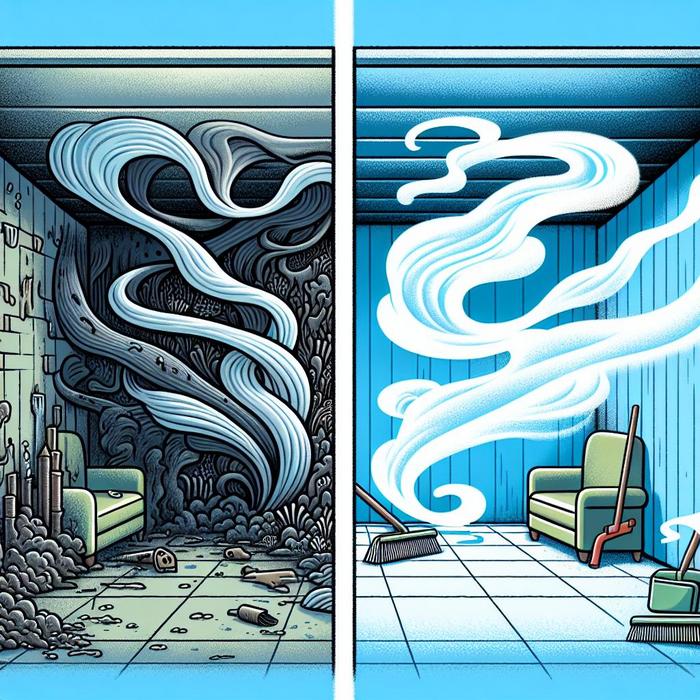Identifying the Unwanted Odor
One of the most common issues homeowners and property managers face is the persistent smell in basements. This issue is not just an annoyance; it could indicate a serious problem. Often, the culprit behind these odors is mold, which thrives in the damp, dark corners of basements. To clear the air and tackle the basement mold odor, we must first understand what’s causing it.
Indicators of mold presence not only include the distinct musty smell but also seeing discolored patches or feeling dampness in areas. However, homeowners often overlook these signs, unaware of the potential health risks associated.
Health Risks of Mold Exposure
Understanding the potential health risks of prolonged mold exposure is central to understanding why addressing basement mold odor is critical. Inhaling mold spores over a long period could lead to allergic reactions like sneezing, coughing, skin irritation, and severe respiratory issues. Particularly for those with existing respiratory problems or weakened immune systems, extended mold exposure can pose significant health risks.
Causes of Mold in Basements
Mold growth could occur due to several reasons. Basements are often more susceptible to mold growth due to their tendency to remain damp and poorly ventilated. Another common cause of mold growth is water damage which can come from flooding, leaky pipes, or condensation.
Water Damage and Mold Growth
Water damage can lead to the perfect environment for mold growth. This is why it’s important to take immediate action when a basement suffers water damage. If left untreated, water damage can not only cause the basement to emit a musty smell, but it could also catalyze rapid mold growth. If you’re curious about the relationship between water damage and mold growth, visit our ultimate guide on water damage and mold to gain in-depth insights.
Restoration Techniques and Equipment: Key to Removing Basement Mold Odor
Restoration techniques and equipment play a critical role in eliminating basement mold odor. Experts use dehumidifiers to control moisture levels, air scrubbers to filter air, and other specific techniques like dry ice blasting, soda blasting, and sanding to effectively remove mold patches.
Professional Restoration Services for Mold Removal
Confronting a basement mold odor issue might require professional help. Mold removal is not merely about masking the smell but about completely eliminating the root cause. If you’re dealing with a persistent mold smell that doesn’t dissipate despite your efforts, it might be time to call in a professional restoration service.
Prevention: The Best Defense Against Mold Growth
In the battle against mold, prevention is indeed the best defense. Techniques like proper ventilation, controlling humidity, regular home maintenance, and quick water damage repair can help deter mold growth entirely.
Understanding the Importance of Insurance and Legal Compliance in Mold Remediation
While taking steps to mitigate mold growth, it’s also essential to understand the importance of insurance and legal compliance in mold remediation. Many homeowners’ insurance policies exclude mold coverage, making it a good idea to understand your policy’s exact terms. Moreover, depending on your state, there might be specific laws and regulations regarding mold remediation.
Final Word
Effectively removing basement mold odor requires more than just masking the smell with air fresheners; it requires addressing the root cause: mold growth. By being proactive in preventing mold growth, responding quickly to water damage, and seeking professional help when necessary, you can effectively keep your basement mold-free and your air clear. Not only does this create a more pleasant environment in your home, but it also ensures the health and wellbeing of those living in your home.
The Process of Identification
Detecting the presence of mold calls for vigilant attention to its common signs and indicators. The strong, musty smell is a red flag that should not be overlooked. Often enough, this smell could be the first and only sign of mold infestation, especially when the issue is hidden out of sight within walls, under the floor, or in corners of the basement. Another identifying factor is visible discoloration which can appear as dark or greenish patches on surfaces. An increased level of humidity or dampness in an area also signals mold growth.
When it comes to gauging the issue, homeowners often tend to undervalue and hence overlook these signs. The lack of awareness extends to an absence of understanding about the potential health risks linked to mold exposure.
Repercussions on Health: Mold Exposure
Understanding the health risks related to sustained exposure to mold spores is crucial to grasping the importance of dealing with basement mold odor. Prolonged inhalation of mold spores could catalyze allergic reactions such as constant sneezing, nagging cough, skin irritation, and severe respiratory issues. It poses heightened risk for individuals with an existing respiratory condition or a suppressed immune system. Persistent exposure to mold can indeed escalate into a severe health risk.
Reasons Behind Mold Infestation in Basements
There could be myriad reasons leading to mold growth. Certain characteristics of basements such as perpetual dampness, poor ventilation, and fewer exit points make them hot spots for mold growth. Apart from these causes, an equally common source of mold growth is water damage. This can be a fallout of numerous factors including flooding, leaky pipes, condensation, etc.
The Connection Between Water Damage and Mold Growth
Water damage caused by various factors lays the ideal ground for mold to grow. It is thus crucial to address any situation of water damage without delay. Neglect in dealing with water damage not only can instigate a persistent musty smell in the basement but could also act as the catalyst for mold growth. If you need more detailed information about the relationship between water damage and mold growth, browse through our comprehensive guide on water damage and mold.
Role of Restoration and Equipment in Remedying Basement Mold Odor
Efficient usage of restoration tools and techniques has key importance in getting rid of basement mold odor. Restoration experts leverage dehumidifiers to maintain optimal moisture levels, air scrubbers to purify the air, and specially designed techniques like dry ice blasting and soda blasting to efficiently remove mold patches. Sanding is also a preferred option to address mold infestation.
Why You May Need Professional Help in Mold Removal
Effectively addressing a basement mold issue might warrant professional assistance. Usually, mold removal not only involves covering up the smell but confronting and entirely removing its root cause. If you find a stubborn mold smell in your basement that doesn’t fade away despite your attempts, it might be time to bring in professional restoration services.
Prevention: Your Best Weapon Against Mold Growth
When fighting mold, prevention stands to be the most potent defense. Techniques such as adequate ventilation, humidity control, regular home maintenance can deter mold growth. Likewise, swift water damage repair can prevent the setting up of an environment conducive to mold growth.
Why Insurance and Legal Adherence Matter in Mold Removal
As you take steps towards mitigating mold growth, it’s crucial to realize the significance of insurance and legal adherence in mold removal. Many homeowners’ insurance policies exclude mold coverage, making it imperative to comprehend your policy’s specific terms. Furthermore, there might be specific laws and regulations pertaining to mold removal, depending on your state of residence.
Straight Talk on Basement Mold Odor Remediation
There’s more to effective removal of basement mold odor than merely masking the smell with the use of air fresheners, it necessitates finding and remedying the root cause – mold growth. Embracing a proactive approach in preventing mold growth, immediate response to water damage, and resorting to professional help when required can practically keep your basement mold-free and your air clean. Not only will this lead to a more pleasant environment in your home, but it also ensures the health and safety of the occupants. The assurance of a healthy living environment is the ultimate goal for every homeowner, and addressing mold growth effectively is a significant step towards achieving it.
Moving Forward After Mold Detection
Detecting the presence of mold in your basement is no reason to panic. With the right approach and the expert help of professional restoration services, the issue can be dealt within an entirely safe and effective manner. It’s essential to have a well-laid plan and take immediate action to secure your property from potential health hazards. Dealing with mold may appear daunting, but with adequate knowledge, professional intervention, legal compliance, and proper preventative measures, it’s quite manageable.
Combining Proactive Measures and Professional Help
Being proactive towards mold growth prevention, addressing water damage quickly, and seeking professional help when necessary, is a beneficial strategy for keeping your basement free from mold or unwanted odors. This approach not only maintains a comfortable environment in your home but also safeguards the health of those living in the house. With a proactive and informed approach, you can keep your living environment clean, safe, and pleasant. Your understanding of the importance of mold remediation along with the right actions can ensure a safe and healthy home.

